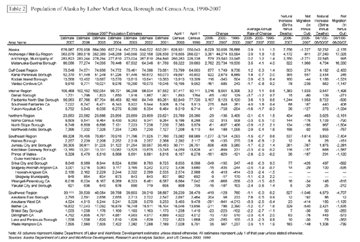Southeast region continued to have largest overall population decline
Alaska's statewide population increased 7.9 percent, or 49,454 people, from 2000 to 2007, based on new population estimates released Friday by the Alaska Department of Labor and Workforce Development.
Alaska's growth was slightly faster than the 6.9 percent increase for the United States as a whole during the seven-year period. (Unless otherwise indicated, all population estimates have a reference date of July 1. The 2007 estimates are provisional.)
The number of people living in Alaska climbed from 627,533 in 2000 to 676,987 in 2007 (See Table 1). Alaska's average annual rate of population change was 1.1 percent during the 2000-2007 period and 0.9 percent for the 2006-2007 period. Alaska is still the 47th most populous state, and is larger than North Dakota, Vermont, the District of Columbia and Wyoming.
Currently, growth in Alaska as a whole is primarily through natural increase. From 2000 to 2007, Alaska's natural increase (births minus deaths) added 50,486 people, while net-migration (in-migration minus out-migration) accounted for a loss of 1,032 people. During the 2006-2007 period, Alaska added 7,756 people through natural increase and lost 1,727 people to net out-migration.
In the early 1990s, Alaska added an average of 8,100 people each year through natural increase. A gradual decline in births and a gradual increase in deaths - both tied to an aging population - have resulted in a slowdown in natural increase to about 7,300 people a year.
When international and domestic migration are considered separately, the loss of 1,727 migrants between 2006 and 2007 breaks down to a gain of 602 international migrants and a loss of 2,329 domestic migrants. Thus, international migration is currently compensating for some of the outward domestic migration. About 70,000 people now migrate to and from Alaska each year. In- and out-migration are nearly equal at about 35,000.
"It is important to note that, because our estimates are for resident population, any troops deployed overseas are counted as being in Alaska in our estimates," said Greg Williams, state demographer. "This means that the populations for the Fairbanks North Star Borough and the Municipality of Anchorage, where the main Alaska military bases are located, as well as other communities with a substantial National Guard presence, may be somewhat lower than these estimates indicate, depending on the current deployment of military and National Guard personnel."
Boroughs and Census Areas
Department of Labor population estimates have also been released for Alaska's 28 boroughs and census areas (see Table 2), as well as for 343 places located throughout the state. Unlike Table 1, which considers population change from the average annual population in 2000, Table 2 considers population change from the April 1, 2000 U.S. Census.
 Population of Alaska by Labor Market, Area, Borough and Census Area, 1990-2007 Click on the Table 2 for a larger graphic. |
Most of Alaska's boroughs and census areas grew slowly or lost population between the 2000 Census and 2007. Of the 28 boroughs and census areas, 10 gained population between 2000 and 2007. The largest population increases occurred in the Municipality of Anchorage (+23,540), Matanuska-Susitna Borough (+20,734), Fairbanks North Star Borough (+8,123), Kenai Peninsula Borough (+2,679), Southeast Fairbanks Census Area (+848), Bethel Census Area (+786) and Wade Hampton Census Area (+567).
Population growth in the Municipality of Anchorage and the Mat-Su Borough accounted for roughly 76.5 percent of the growth in those 10 boroughs and census areas. The Municipality of Anchorage made up 40.7 percent of the growth, with population gains in the Mat-Su Borough making up 35.8 percent.
The Mat-Su Borough continued in 2007 to be the fastest-growing area in the state, as it has been since 1990. Between 2000 and 2007, it grew at an average annual rate of 4.1 percent, which is slightly greater than its 4.0 percent annual growth rate during the 1990s. However, its growth slowed to 3.5 percent between 2006 and 2007.
The increases in both the Municipality of Anchorage and the Mat-Su Borough in the 2000-2007 period were due to a mix of natural increase and net-migration. A substantial part of migration to Anchorage comes from other parts of Alaska.
The Mat-Su Borough was the only area of the state where growth came primarily from net in-migration. Since the 2000 Census, net in-migration accounted for 16,030 of the Mat-Su Borough's population increase of 20,734.
The majority of Mat-Su's migration comes from the Municipality of Anchorage. Those two areas, plus the Southeast Fairbanks Census Area (+408) and Kenai Peninsula Borough (+245), were the only areas where in-migration noticeably exceeded out-migration during the 2000-2007 period.
In the more recent 2006-2007 period, Anchorage gained a total of 579 people, while the Mat-Su Borough gained 2,782 people. And while Anchorage had a current natural increase of 3,350 compared to the Mat-Su Borough's 822, Mat-Su gained 1,960 migrants and Anchorage lost 2,771.
Eighteen boroughs and census areas lost population between 2000 and 2007. The Southeast region continued to have the largest overall decline, losing 5.1 percent of its population since 2000, with a natural increase of 3,650 people and a net out-migration of 7,404 people. No Southeast area had long-term growth between 2000 and 2007.
http://www.sitnews.us/0208news/021008/021008_ak_population.html
